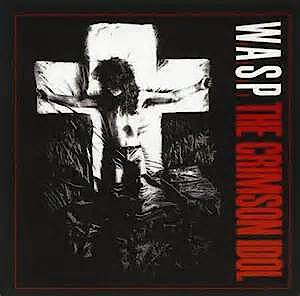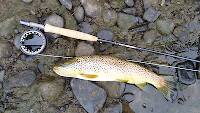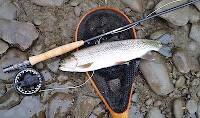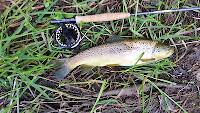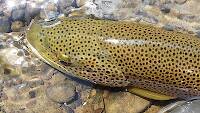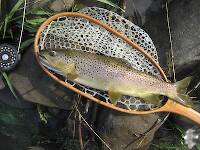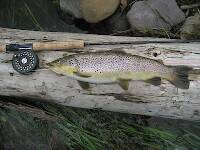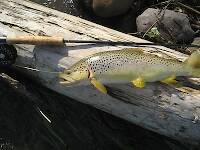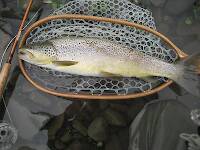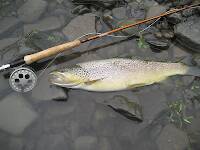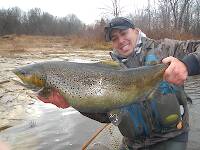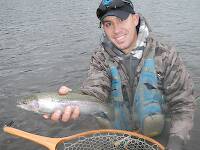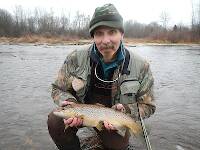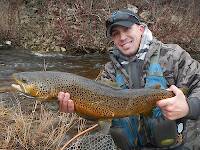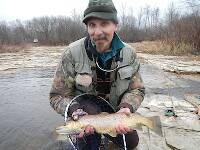
Salmonflies
Pteronarcys californica
The giant Salmonflies of the Western mountains are legendary for their proclivity to elicit consistent dry-fly action and ferocious strikes.
Featured on the forum

Troutnut is a project started in 2003 by salmonid ecologist Jason "Troutnut" Neuswanger to help anglers and
fly tyers unabashedly embrace the entomological side of the sport. Learn more about Troutnut or
support the project for an enhanced experience here.
Adirman on Jun 8, 2016June 8th, 2016, 5:48 pm EDT
Hello to all, so I have a question: How does the Leisenring lift work when blind fishing? From what Ive read, Jim Leisenring utilized his now famous technique when anticipating or actually seeing trout present in good trout lies so that he could induce a take. Basically, the lift is effective when trout are feeding on nymphal/pupal forms in the process of emerging and he would stop his rod to imitate the emergence of the insect as it rose to the surface correct?
Oldredbarn on Jun 9, 2016June 9th, 2016, 7:38 am EDT
How does the Leisenring lift work when blind fishing?
In my opinion its not unlike prospecting with a dry fly when there is no hatching activity present, or at least evident to the angler. You can "pound up" a willing trout with a dry fly without ever seeing it rise. Some fish may be looking for a meal, or they were stimulated to feed when you presented your offering. Think attractor patterns...They are designed to get the fishes attention and are "in the ballpark" in terms of something a trout would eat.
After years of fishing an area an angler understands what bugs should be hatching and it isn't a bad idea to search with say an emerger, or a nymph of a fly you anticipate should be around or on the water.
There are likely places a fish might be in a river...Bubble lines, near structure or behind rocks, and tossing a fly there in slow periods might get you a fish.
Fishing "blind" in either case, dry-fly or nymphing, can, on the other hand, be like trying to find a needle in a haystack. You may pound the river into a froth, but if the fish aren't interested, inducing them to do anything may be futile.
I once asked our own Tim Neal what he did during a Trico hatch...Tim is what we call around here in Michigan one of the Grayling Boys and they have their own take on fishing either the Manistee or the Au Sable. It usually involves what the rest of us would call large flies...
Well...Tim's answer was that he ignored the Trico hatch and just slept in like any civilized fella should, and after the hatch was over, and the angler has finished his breakfast, and that second cup of coffee, he would hit the river and run a small Madsen Skunk through the feeding lanes.
I asked him what he considered a "small" skunk, and he said a size 10...:)
Nothing pleases a Grayling Boy more than when the large flies show up and he never has to go below a size 10 for any reason for the rest of the season...
Rusty Gates had a fly he called the White Not/or Knot (depending on who you asked). It is an Iso imitation and from late May or early June you can fish it as a prospecting fly...Iso's can be around almost anytime between late May and say September (give or take)...I have fished it right along logs in the river in the middle of the day, when absolutely nothing was going on, and shocked old man Brown trout from his slumber there and caught some nice fish...No hatching activity going on, and no rises. Rusty called it "working the lumber, or running the logs".
It is slow fishing, but if you are good at it, and take your time, and can put your fly right up against the structure, you can pick apart a river on an otherwise slow day.
You should be getting snagged from time to time, or you aren't close enough to the timber.
But this is Au Sable fishing, not the Madison...We have lazy nocturnal Browns that hide all damn day up under under-cut banks, under logs, and wood piles...Sulky they are! This is why I have said that if a guy can consistently catch nice Browns on the Au Sable he will wet his pants when he gets to Montana...Out there, there is no place to hide...
I know this is a ramble, but somewhere in it all there is my answer to your question.
Spence
Oh...then there is getting up really early and being the first guy on the river and prospecting with a spinner that was around the night before, but that's another story...
"Even when my best efforts fail it's a satisfying challenge, and that, after all, is the essence of fly fishing." -Chauncy Lively
"Envy not the man who lives beside the river, but the man the river flows through." Joseph T Heywood
"Envy not the man who lives beside the river, but the man the river flows through." Joseph T Heywood
Jmd123 on Jun 9, 2016June 9th, 2016, 12:00 pm EDT
"You can "pound up" a willing trout with a dry fly without ever seeing it rise. Some fish may be looking for a meal, or they were stimulated to feed when you presented your offering. Think attractor patterns...They are designed to get the fishes attention and are "in the ballpark" in terms of something a trout would eat."
Extremely true, Spence. I catch plenty of fish on my home waters that are not actively rising but will go for an Elkhair caddis, Adams, Royal Wulff, etc. My latest "secret weapon" is a #10 cricket pattern, which is not only tearing up the brookies now at [REDACTED] Pond but got three browns for me on the Rifle last week. The reason I tried this pattern? I have been hearing crickets singing at night, seems awfully early but they're there, and apparently fish like them too. I am thinking of it as "pre-hopper" fishing...
Jonathon
Extremely true, Spence. I catch plenty of fish on my home waters that are not actively rising but will go for an Elkhair caddis, Adams, Royal Wulff, etc. My latest "secret weapon" is a #10 cricket pattern, which is not only tearing up the brookies now at [REDACTED] Pond but got three browns for me on the Rifle last week. The reason I tried this pattern? I have been hearing crickets singing at night, seems awfully early but they're there, and apparently fish like them too. I am thinking of it as "pre-hopper" fishing...
Jonathon
No matter how big the one you just caught is, there's always a bigger one out there somewhere...
Quick Reply
Related Discussions
Topic
Replies
Last Reply
2
Feb 8, 2011
by Pryal74
by Pryal74



